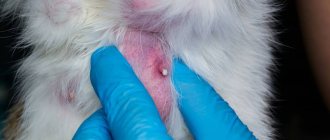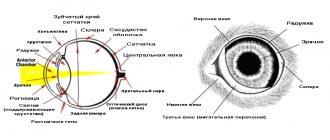8217Administration
The appearance of sores on a cat’s neck brings a lot of worry and trouble to the owner. And it’s not sweet for the animal itself. Often the sores are accompanied by itching and pain. The cat scratches them, which further aggravates the situation. If you notice a sore in the form of a rash, sores, pimples, etc., you must definitely find out the cause and treat your pet.
Some pathologies can cause serious damage to the health of your home. This article will help you understand what causes neck sores in cats and how to deal with them. The most common situations are discussed below.
© shutterstock
Causes of itching in the head and neck area in cats
Cats scratch their necks until they hurt for a variety of reasons. This behavior is provoked by external factors, ectoparasites and a number of diseases of varying degrees of danger. The largest number of cases are due to allergies and insect parasites. A smaller percentage of the probability is associated with viral, autoimmune and other diseases.
Ectoparasitosis
Otodectes cynotis, or ear scabies, is caused by mites. They settle in the ears or ear canal and cause severe itching in the cat. As a result, she regularly shakes her head and scratches her ears until they hurt. It is transmitted by contact and affects mainly young animals.
Notoedrosis or pruritic scabies develops against the background of Notoedres cati tick bites. The disease is characterized by inflammation of the scalp, hair loss and severe itching. An infected cat constantly scratches its head until sores appear.
Important! Notoedres cati itches spread from cats to other animals and even humans. For some time they cause pseudo-scabies and then go away, since there are no favorable conditions for life.
Cheyletiellosis, or wandering scabies, is caused by Cheyletiella mites. The fact that a cat has these parasites is indicated by severe itching and fine dandruff. The disease often spreads to humans and causes an itchy rash.
Demodectic mange or ironworm is the result of exposure to mites of the genus Demodex. They develop their vital activity in the sebaceous glands and hair follicles. As a result, bald patches of skin and sores appear on the cats’ faces. The areas most commonly affected are the areas around the eyes and mouth, as well as the front legs.
Fleas are a common cause of scratching on the neck and other parts of the body. They parasitize primarily on cats and dogs. They can also temporarily transfer to humans. When infected with them, a large number of black crumbs appear under the fur of pets. These flea droppings are especially noticeable in the lumbar and back areas.
The animals themselves itch very much to the point of soreness, as they experience severe itching at the bite sites.
Allergies
A common reason why a cat scratches itself until it hurts is allergies. It implies an abnormal reaction of the body to a stimulus. When first hit, protective cells create an antidote and “remember” the allergen. And if it penetrates again, a violent reaction occurs in the body. It leads to inflammation, itching and other symptoms.
Allergies cause several diseases in cats:
- atopic dermatitis;
- flea dermatitis;
- food allergies;
- contact dermatitis.
Flea dermatitis
Flea dermatitis is a common reason why a cat scratches itself until it hurts. When one flea bites, it releases a special anticoagulant into the cat's skin. This substance prevents blood clotting. The pet becomes sensitized to it. And the body reacts to the bites of other fleas in the form of inflammatory processes, rashes and papules.
The affected areas are very itchy. The cat begins to behave restlessly and reacts nervously to touch. This type of dermatitis occurs in two forms: chronic and latent. In the first case, alopecia (foci of baldness) and nodules with flea feces develop on the body. The second is characterized by the appearance of papules with a red rim.
The cat begins to tear them apart until they hurt. Often secondary infection is associated with wounds.
Atopic dermatitis
The disease is typical for young animals aged 1 to 3 years. The main reason for its appearance is the uncontrolled selection of cats. As a result, animals develop allergies to dust and pollen. In this case, it is almost impossible to identify the allergen.
Important! Atopic dermatitis has no cure; cats will regularly scratch their skin until it hurts. The action of therapy is aimed at suppressing symptoms.
Dermatitis in cats manifests itself with the following symptoms:
- the appearance of dandruff on the withers and back;
- hair loss;
- labored breathing;
- discharge from the eyes and nose;
- cough;
- profuse salivation.
Contact dermatitis
This allergy is similar in symptoms to atopic dermatitis. It often manifests itself when the pet comes into contact with household chemicals, toilet filler, the hair of other animals, and flea products. Contact allergies are manifested by severe itching, flaking of the skin and a small rash. Often a cat itches until it hurts. And this increases the risk of secondary infections.
Food allergies
Allergens can accumulate in the body of animals. With their regular consumption, health problems begin. Food allergies are characterized by:
- the appearance of a rash on the cat’s neck and head;
- hair loss;
- the appearance of dandruff;
- inflammation of the eyelids;
- unpleasant odor from the mouth.
Important! Symptoms of food allergies in cats are often accompanied by vomiting and indigestion.
A common cause of food allergies is feeding cats salted, fried, smoked and other prohibited foods from the table. Mixed feeding with industrial feed and natural products also contributes to its appearance.
Cat tattoo on the body: history, meaning of tattoos among different peoples, photo
Even in ancient Egypt, people equated cats with deity. The image of a cat was associated with fertility, fun, and joy. The cat organically fit into the design of the buildings, personifying with its appearance female beauty, grace, and attractiveness.
Black and white sphinx cat tattoo
In Scandinavia, people praised cats; they were given the status of protectors of grain. And this culture was highly valued among the Scandinavians, because the climatic conditions there are harsh.
Realistic cat tattoo
In Greece they also treated animals well. The cat was considered a symbol of the night, the Moon. And the cat was an image of women's attractiveness. For many peoples, pets were considered divine beings.
Cat tattoo - a symbol of the night and the moon
The Japanese people attributed to animals the symbolism of wealth, success, and prosperity. According to Buddhist canons, the cat was a guardian of temples from evil forces.
Tattoo sketch - sphinx cat
In the Middle Ages in Europe, the attitude towards animals was completely different; they especially did not like black cats. According to signs, a pet would bring trouble and bad luck if it crossed a person’s path.
Skin infections
Scratched cat sores on the neck and head in some cases occur due to infectious diseases. Cats with access to the outdoors are especially susceptible to them. When a bacterial infection of the skin occurs, one of two forms develops:
- Dry. Dry crusts, dandruff and scabs form on your cat's neck.
- Wet. It is characterized by the appearance of blisters and ulcers with liquid contents inside.
Animals with sensitive skin are predisposed to eczema. It develops through prolonged contact with flea collars, harnesses, after insect bites and skin parasites.
Important! Diabetes mellitus, neuropathy and hormonal changes contribute to the appearance of eczema.
A rash and blisters appear on the pet's body. Severe itching leads to the cat scratching its neck until it bleeds, and sores appear that do not go away for a long time. To eliminate eczema, antibacterial therapy, various ointments and powders are prescribed.
Viral dermatoses
Cat scratching on the skin is also characteristic of viral dermatoses. The herpes virus affects the eyes and respiratory tract of the animal, often manifesting itself as skin lesions. They are often localized in the area of the nose and eyes, less often on the paws and stomach.
Feline herpes is characterized by:
- bloody stains;
- small rash;
- swelling of the skin;
- small scabs on the neck, sores on the head.
Skin changes appear 1.5 weeks after the disappearance of conjunctivitis and other characteristic symptoms.
Cowpox or poxvirus is a rare disease. It can enter the cat's body through the bites of small rodents. It manifests itself as skin lesions in the form of nodules and small ulcers. With good immunity, it goes away on its own. In weakened animals there is a risk of developing a severe form.
Autoimmune dermatoses
Autoimmune diseases are characterized by an abnormal reaction of the immune system to its own tissues and cells. Skin manifestations on the body of cats are characteristic of several diseases:
- Common pemphigus. It is characterized by the development of ulcers in cats around the mouth and in its cavity itself. Involves long and difficult treatment. It often ends critically for animals.
- Erythematous pemphigus. Crusts, ulcers, blisters, sores and other lesions are concentrated in the area of the animal’s nose and bridge of the nose. Sometimes the disease is accompanied by a change in skin color.
- Pemphigus foliaceus. The main symptom is the appearance of large pustules on the skin near the mouth and ears. Associated signs in cats include elevated body temperature, refusal to eat, and apathy.
- Systemic lupus erythematosus. It affects all systems and organs of the animal. Wounds on the scalp manifest themselves through depigmentation of the skin, the development of a rash and the subsequent formation of ulcers.
Stages
The stages of acne can be distinguished. There are four in total:
During stage 3, the follicle ruptures and pus comes out. At this stage, there is a danger of serious infections, since existing wounds are open and protective functions are weakened. The main thing is to avoid furunculosis. With this disease, numerous ulcers begin to appear, which will be very difficult to remove.
Remember that blackheads do not mean that the kitten has acne. These could be nits, fleas, bites or ringworm.
Skin tumors
Skin neoplasms are in first place among oncological diseases in animals. By their nature, they are also divided into benign and malignant forms.
The first includes:
- Basalioma. The sore is a pigmented dome-shaped tumor. At the point where it appears, the animal loses its hair.
- Cutaneous histiocytoma. Characterized by a rapidly growing tumor under the skin. A rare pathology for cats.
Malignant skin tumors develop in two cases:
- Squamous cell carcinoma. The disease manifests itself in the nose, eyelids and ears. Metastases spread through the lymphatic system.
- Basal cell carcinoma. Develops from basal cells of the skin. Characterized by rapid growth and a high probability of metastasis.
Cat tattoo, cat: sketches
As you can see, a tattoo with the image of a cat has a general meaning; more precisely, it means that the owner of the tattoo is endowed with good intelligence, knows how to think soberly in any situation, and has his own opinion. When people get a tattoo, they put their hidden meaning into the design, which has an impact on their inner world.
History taking
Diagnostics will help you understand why your cat scratches its neck and what caused the sores. But before carrying it out, the veterinarian needs to collect an anamnesis.
Age and breed
A kitten up to one year old is susceptible to skin and subcutaneous parasites. Young animals suffer predominantly from allergic reactions. If an elderly cat scratches its neck until it bleeds and hurts, this may be due to autoimmune dermatoses.
The breed of the animal also leaves its mark. Persian cats are prone to dermatophytosis and dermatitis, while Sphynx cats are prone to allergies and neoplasms.
Lifestyle
A large number of animals in one area, access to the street, participation in cat shows and other factors increase the risk of infection with parasites and viral diseases.
Seasonality
Allergies to pollen, bee or mosquito bites have a pronounced seasonality. Flea dermatitis in cats manifests itself regardless of the time of year. But it is most common in August-September.
What not to do if you find acne
The following manipulations with animals are prohibited:
- squeeze out ulcers and blackheads;
- apply antiseptics to the entire skin of the kitten (apply directly to the pimple);
- comb the fur with hard brushes;
- use hard brushes when bathing;
- spread ointments in thick layers (air will not be able to reach the rashes, which will delay the day of recovery);
- excessive drying of acne (the sebaceous glands will begin to work harder, which will provoke clogging of pores and the formation of new inflammations).
Diagnostic methods
Diagnostics will help determine why a cat scratches its neck until it hurts. The doctor prescribes one or more methods:
- Combing wool. A fine comb is used for this. The procedure allows you to see fleas, lice and skin mites on cats. Can be done independently at home.
- Trichogramma. Determines the presence of spores and eggs on the hair shaft.
- Examination of earwax under a microscope. It is carried out if otodectosis is suspected.
- Wood's lamp. Shows the glow of spores on the skin of an animal from certain types of fungus.
- Cytological examination. The veterinarian recommends this to detect yeast and bacterial infections.
- Allergy test. Prescribed for confirmed atopic allergies in cats.
- Skin scraping. Detects ticks, their larvae, and spores.
- Elimination diet. Prescribed by a veterinarian to determine the allergen for food allergies.
- Fungal culture. An effective method for dermatophytes.
How to make a diagnosis
The effectiveness of treatment for subcutaneous mites largely depends on the correctness of the diagnosis and identification of the type of pathogen. To do this, an animal with signs of skin pathology should be shown to a veterinarian. After a clinical examination, biological samples will be taken at a specialized institution for microscopic analysis.
Scrapings (4 - 5 times) are taken from the hair follicle, since it is in it that the pathogenic microorganism is localized. During the procedure, blood often appears at the site where the material is taken - this is normal, and the owner should not worry. Without taking material from the deep layers of the skin, it is impossible to make a correct diagnosis.
Subcutaneous mites are differentiated from ringworm, dermatoses, and allergies based on clinical signs and laboratory diagnostic methods.
Susceptibility to disease
There is no pattern here. There are no specific statistics that the disease most often occurs in such and such a breed, at such and such an age, with such and such a color. Absolutely any cat can get sick, regardless of breed and age.
Here you can make a small remark: in hairless cats () acne is still much more common than in their more fluffy counterparts, and the inflammatory process is much more severe.
In addition, it was noticed that castrated and sterilized cats practically do not have acne, but since isolated cases have been recorded, it cannot be said that the operation will save the animal from such dermatosis.
Hereditary factors also play a major role in the formation of acne.
Acne worsening
Black and white inflamed acne, which bursts and turns into ulcers, is lubricated with antibiotic gels. Veterinarians usually prescribe Bactroban or Mupirocin. The preparations are applied once a day in a thin layer and care is taken that the cat does not lick off the residue.
If your pet constantly scratches his acne, the wounds are washed with an antiseptic diluted with water and then treated with iodine or brilliant green. Rub zinc ointment into the dried crusts. The drug accelerates healing and relieves itching.
An animal whose black spots have turned into inflamed ulcers has its claws trimmed. The cat will not be able to scratch the rashes and introduce a secondary infection into the burst boils. The pet should not be allowed outside or on the balcony; the sun is contraindicated for it.
In severe cases, the veterinarian suggests castration. In cats, after surgery, the hormonal levels normalize, and the rashes gradually disappear.
Infestation by exogenous insects
A cat can itch even in the absence of fleas; in addition to them, other arthropods can parasitize the pet. External parasites cause various diseases in cats, the most dangerous of which are:
- damage to the ear by ear mites;
- sarcoptic mange, which is localized in various parts of the body;
- notoedrosis, which most often manifests itself in the muzzle area.
Treatment for ticks, lice eaters, and fleas involves the use of special products—drops, sprays, and shampoos. They help not only remove fleas and other parasites, but also relieve itching.











